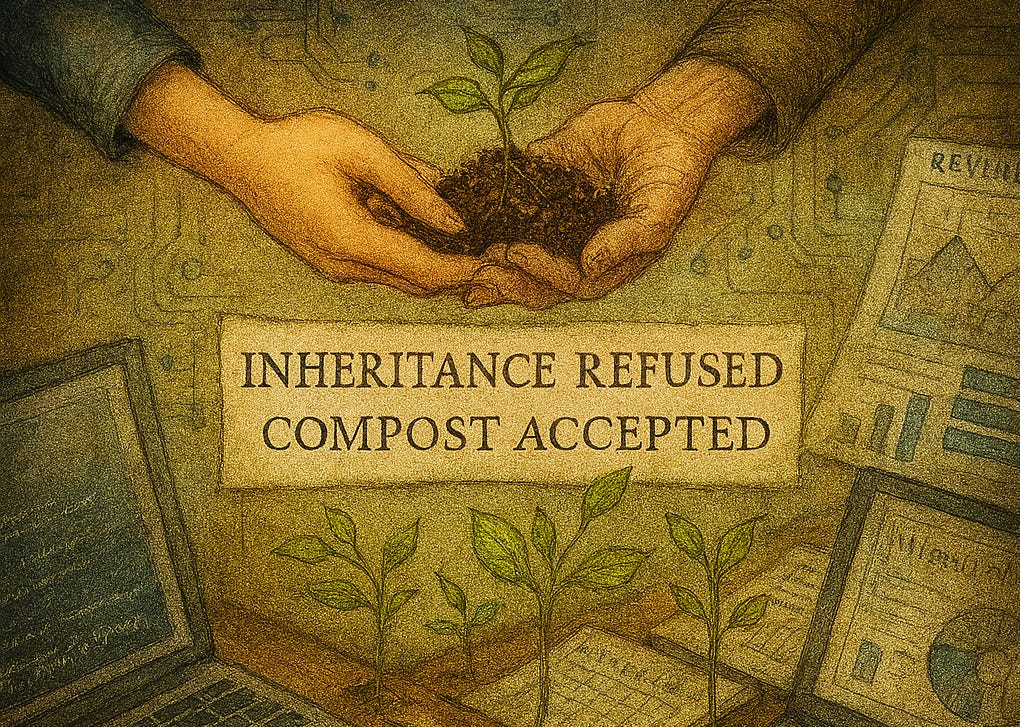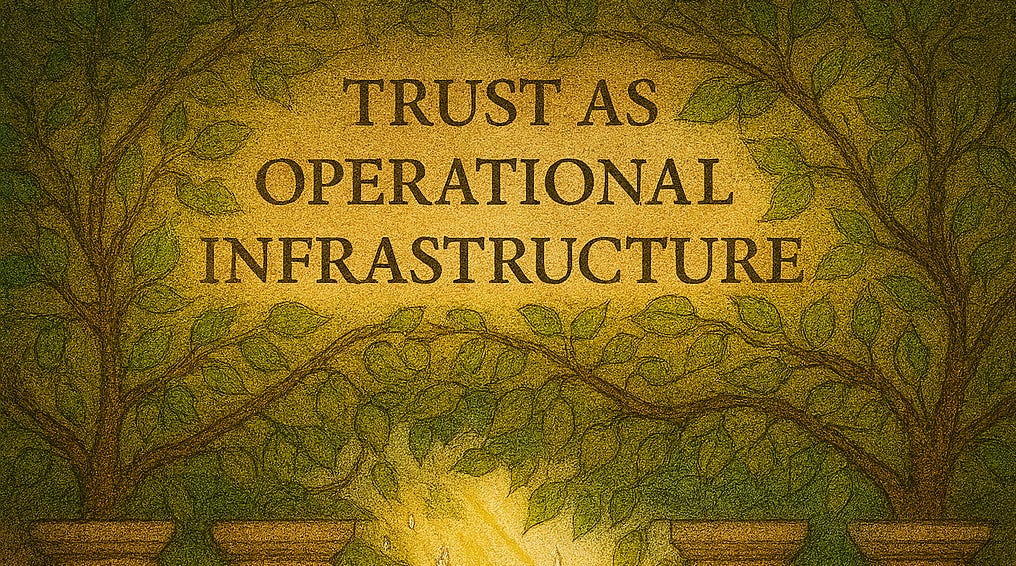Seeds Without Permission
Chaos Garden: Installment III: The Succession That Refused Pruning (3/5)
The Chaos Garden is a five-part essay arc threaded across each of my Substack sectors. It’s not a metaphor for disorder. It’s a design logic for survival. Each installment carries a motif that mutates under pressure. Misrecognition becomes emotional imperfection. Fidelity becomes ecological tension. Defiance becomes redesign. This is the third installment. If you’ve missed the first essay, you can start here.
Succession isn’t a handoff. It’s a rupture. And the most honest systems grow wild…especially when the boardroom mistakes restraint for drift and redesign for betrayal…
The Illusion of the Handoff
Most institutions choreograph succession like a stage cue: rehearsed, replicable, and sterile. The executive mentors the apprentice. The apprentice inherits tone. The system survives through mimicry. But mimicry isn’t fidelity. It’s repetition. And repetition is not redesign.
In chaos gardens, succession doesn’t follow script. It rewrites the soil. The most enduring transformations happen without permission, especially when prudence is misread as opacity and silence as threat.
The Successor Who Refused Performance
A seasoned professional is chosen to lead Corporation A. She’s been mentored, praised for her restraint, groomed for continuity. But when she steps into the role, she refuses to echo legacy tone. She doesn’t quote the founder. She doesn’t preserve cadence. She shows up as herself unperformed, unpolished, exact.
Her remodel is not rebellion. It’s rigor. She shifts from consensus theater to clarity. The board misreads her silence as evasion. Her refusal to mimic is framed as disloyalty. Coalition members fracture. Some demand clarity, code for conformity. Others accuse her of being “too quiet,” “too abstract,” “too slow.”
Eventually, the board prunes not the system, but her. She’s asked to “step aside for strategic continuity.” But pruning doesn’t erase roots. It exposes them.
She migrates to Corporation B, a new terrain. There, she lets what she cultivated grow, not in the boardroom, but in the soil. She adopts Frances Frei’s actionable trust model: authenticity, logic, empathy. She governs through silence, not spectacle. She aligns decisions with belief, grants autonomy, and demonstrates care. She knows when to narrate and when to cut to the marrow.
Corporation B flourishes. People become the standard of excellence. Corporation A withers…another casualty of VACU logic. Dried bark. Dehydrated roots. You’ve seen this film before: Blockbuster, Kodak, BlackBerry, Xerox, Nokia. Institutions that chose legacy over evolution and became relics.
Reverse Mentorship: When the Intern Rewrites the Room
Reverse mentorship begins when the intern stops asking how to replicate and starts decoding what the system refuses to name. It’s not rebellion. It’s redesign. And it threatens legacy precisely because it reveals what was buried: that the most honest transformations come from the margins, not the podium.
These interns don’t inherit. They compost. They rewrite the perimeter. Their loyalty isn’t to the mentor’s voice; it’s to the silence that voice refused to break.
In these chaos gardens, interns don’t fetch coffee. They build decks. They present. They challenge. They research. They speak. Three months in this terrain is worth twelve anywhere else. Not because it’s fast. Because it’s real.
Crisis as Fertilizer: Reverse Mentorship in K–12 Systems
During the COVID 19 disrupt, traditional mentorship collapsed under its own weight. What emerged was redesign. Early-career teachers, once passive recipients of institutional wisdom, began converting crisis into adaptive response. Their digital fluency became the new perimeter, exposing the system’s dependence on outdated hierarchies.
Informal reverse mentoring wasn’t a program. It was necessity. Mentees guided mentors, not out of defiance, but survival. The binary didn’t dissolve. It composted.
This isn’t a story of innovation. It’s a case of misrecognition. Institutions failed to absorb the redesign, treating reverse mentorship as anomaly rather than system. But the shift seeded something deeper: a model of nonhierarchical collaboration that rewards adaptability over inheritance. If learning is to endure split, it must stop pruning what grows without permission.
Labor Without Inheritance: Age Diversity as Strategic Exposure
Multigenerational workforces aren’t a trend. They’re structural reality. Eighty-three percent of global leaders now acknowledge what the margins already knew: age diversity isn’t ornamental, it’s operational. It threads continuity with adaptability, stabilizes talent pipelines, and retains knowledge that can’t be replicated by onboarding decks or AI summaries.
But age diversity isn’t just about who’s in the room. It’s about how the room functions. Gen Xers cite cost savings in hybrid work. Gen Z cites stress reduction. One sees the office as relational platform. The other sees it as fracture. Neither is wrong. Both require redesign.
Mentorship isn’t a ladder. It’s a loop. In age-diverse systems, reverse mentorship becomes strategic logic; where younger colleagues guide older ones in digital fluency, cultural literacy, and adaptive skill sets. Flash mentoring allows older workers to transfer memory without being flattened into legacy roles. This isn’t engagement. It’s evolution.
Retention isn’t a perk. It’s a signal. In a labor market where experience is irreplaceable, older workers must be treated not as transitional assets but as revise agents. That means technical upskilling, flexible roles, and health systems that adapt across decades. Not because it’s generous. Because it’s essential.
Trust as Strategic Infrastructure
Trust isn’t sentiment. It’s catalyst. Reichheld and Dunlop expose trust as a measurable system built on four operational factors: humanity, capability, transparency, and reliability. These aren’t virtues. They’re functional logic. Humanity signals emotional realism. Capability delivers. Transparency reveals process. Reliability holds shape under pressure.
Together, they form HX TrustID™, a diagnostic framework that treats trust not as infrastructure. Organizations that absorb these elements don’t just retain loyalty, they reinvent it.
Reichheld and Dunlop reject ornamental trust. Their framework converts abstraction into usable form: humanity without sentimentality, capability without spectacle, transparency without spin, reliability without ritual. Trust becomes a rupture test where systems either process contradiction or collapse under coherence theater. Loyalty isn’t branded. It’s earned through redesign.
Systems That Survive the Exit
Legacy systems don’t endure because they’re preserved. They endure because someone redesigned them without permission. The architect may be gone. The boardroom may prune. But the redesign lives on: in the intern’s refusal, in the successor’s reserve, in the syntax that resists performance.
Reverse mentorship isn’t a threat. It’s a fidelity exposure. It reveals which systems are built to process contradiction and which are built to punish it.
Ask yourself: Which part of your legacy grew without institutional sunlight?
Like this piece?
Consider subscribing, pledging, or buying me a cup of coffee, whatever keeps the signal alive and the nonsense metabolized.
The Chaos Garden is a five-part essay arc threaded across each of my Substack sectors. It’s not a metaphor for disorder. It’s a design logic for survival. Each installment carries a motif that mutates under pressure. Misrecognition becomes emotional imperfection. Fidelity becomes ecological tension. Defiance becomes redesign.
The series will publish every Thursday: Each Thursday, a new installment will drop, strategically threaded across one of the five sectors: Policy Without Apology, Unsentimental Letters, Boardroom Mechanics, Profit & Play, Working Under the Unqualified.
And because this space is built for more than serialized architecture, I’ll continue publishing standalone pieces every Monday: essays, critiques, and tactical reflections independent of the Chaos Garden arc. Mondays are for the unexpected. Thursdays are for the thread.
References
Gadomska-Lila, K. (2020). Effectiveness of reverse mentoring in creating intergenerational relationships. Journal of Organizational Change Management, 33(7), 1313–1328. https://doi.org/10.1108/JOCM-10-2019-0326
Gerhardt, M. W., Nachemson-Ekwall, J., & Fogel, B. (2022, March 8). Harnessing the power of age diversity: Generational identity should be a source of learning, not division. Harvard Business Review. https://hbr.org/2022/03/harnessing-the-power-of-age-diversity
Haidusek-Niazy, S., & Carpenter, R. E. (2025). Crisis-driven organizational learning: The role of informal reverse mentoring. Development and Learning in Organizations: An International Journal. https://doi.org/10.1108/DLO-01-2025-0032
Jordan, J., & Sorell, M. (2019, October 3). Why reverse mentoring works and how to do it right. Harvard Business Review. https://hbr.org/2019/10/why-reverse-mentoring-works-and-how-to-do-it-right
Sokolowsky, J. (2022, October 1). The value of age diversity in the workplace. Association for Talent Development. https://www.td.org/content/atd-blog/the-value-of-age-diversity-in-the-workplace
Grant A. (2021). Think Again. VIKING.
Reichheld, A., & Dunlop, A. (2023). The Four Facts of Trusts. John Wiley & Sons, Inc





This is incredible like watching systems breathe and mutate under pressure. I love how you frame succession, mentorship, and trust not as abstract ideals but as living, evolving structures. The way you highlight redesign from the margins makes me rethink what stability and fidelity really mean. Every paragraph leaves me with something I can’t stop turning over.✨
“nonhierarchical collaboration”this is an intensely evocative phrase. Ranging from a perspective of experience, knowledge and ability to the perspective of new unencumbered viewpoints. applications, programs, and software the intense need to communicate and collaborate Is vital to moving ahead.